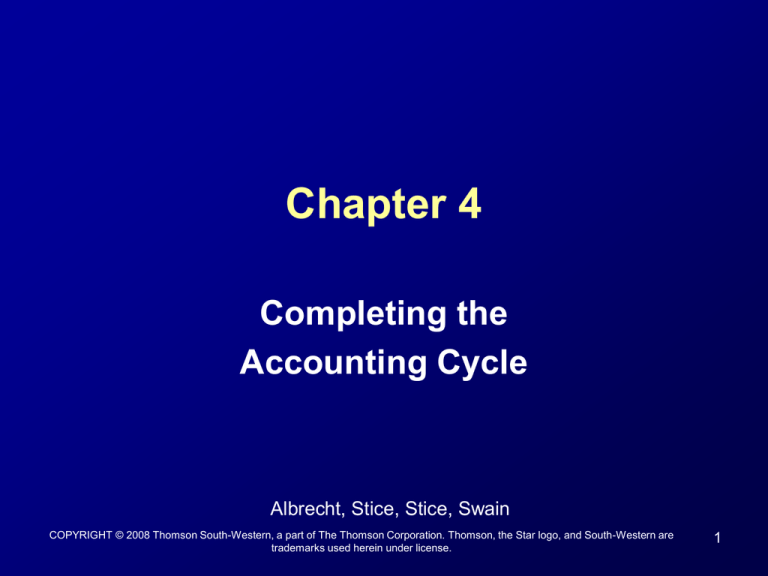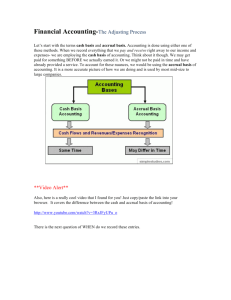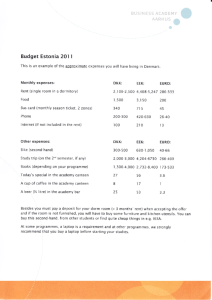Chapter 5
advertisement

Chapter 4 Completing the Accounting Cycle Albrecht, Stice, Stice, Swain COPYRIGHT © 2008 Thomson South-Western, a part of The Thomson Corporation. Thomson, the Star logo, and South-Western are trademarks used herein under license. 1 Periodic Reporting Beginning of Year End of Year • Fiscal Year – 12-month accounting period. • Calendar Year – When an entity closes its books on December 31. 2 Accrual Accounting • What do we do when transactions span more than one period? • Accrual Accounting! – Revenues and expenses are recorded as they are earned and incurred, not necessarily when cash is received or paid. – Better measures a firm’s performance than does cash flow data (?). 3 Revenue Recognition Recognize revenue when: 1. The earning process is substantially complete. 2. Cash has either been collected or collection is reasonably assured. 4 The Matching Principle • All costs and expenses incurred in generating revenues must be recognized in the same reporting period as the related revenues. If revenues are recognized. Related costs and expenses should be recognized. 5 Example: Accrual- vs. CashBasis Accounting During 2009, Bond Consulting billed its client for $48,000. On December 31, 2009, it had received $41,000, with the remaining $7,000 to be received in 2010. Total expenses during 2009 were $31,000 with $3,000 of these costs not yet paid at December 31. Determine net income under both methods. Bond Consulting Reported Income for 2009 Cash-Basis Accounting Cash receipts $41,000 Cash disbursement 28,000 Income $13,000 Accrual-Basis Accounting Revenues earned $48,000 Expenses incurred 31,000 Income $17,000 6 Adjusting Entries • Entries required at the end of each accounting period to adjust the accounts to their proper amounts. – Unrecorded receivables. – Unrecorded liabilities. – Prepaid expenses. – Unearned revenues. • Each adjusting entry involves at least one income statement account and one balance sheet account. 7 Example: Unrecorded Receivables Precision Management earns rent revenue of $500 in 2009 but will not receive the payment until January 10, 2010. An adjustment will be needed. What is the adjusting entry? Rent Receivable Original entry Correct balances Rent Revenue none none 500 500 12/31/09 Rent Receivable Rent Revenue 500 500 8 Example: Unrecorded Liabilities Protege Inc. is assessed property taxes of $1,000 for 2009, but will not make this payment until January 5, 2010. An adjustment will be needed. What is the adjusting entry? Property Tax Expense Original entry Property Tax Payable none none Correct balances 1,000 1,000 12/31/09 Property Tax Expense 1,000 Property Tax Payable 1,000 9 Example: Prepaid Expenses On July 1, 2009, Apex Inc. pays $3,600 for one year’s rent in advance (covering July 1, 2009, to June 30, 2010). On December 31, 2009, an adjustment will be needed. What is the adjusting entry? Prepaid Rent Original entry 3,600 Adjusting entry Correct balances Cash Rent Expense 3,600 1,800 1,800 1,800 12/31/09 Rent Expense Prepaid Rent 1,800 1,800 1,800 10 Example: Unearned Revenues On July 1, 2009, Dahl House Co. received $3,600 for one year’s rent in advance (covering July 1, 2009, to June 30, 2010). On December 31, 2009, an adjustment will be needed. What is the adjusting entry? Rent Revenue Original entry Cash Unearned Rent 3,600 Adjusting entry 1,800 Correct balances 1,800 12/31/09 Unearned Rent 1,800 Rent Revenue 3,600 1,800 1,800 1,800 11 The Closing Process • The Closing Process – Record entries that reduce all nominal accounts to a zero balance at the end of the accounting period. – Nominal accounts are closed to retained earnings. Income Statement Revenues xxx Beg. Bal. xxx Bal. xxx Revenues Expenses Expenses Bal. xxx xxx Balance sheet 12 Net R. Earning Closing Entries • Step 1: Close all revenue accounts by debiting them. • Step 2: Close all expense accounts by crediting them. • Step 3: The difference between revenues and expenses (net income) should be credited to retained earnings. Revenues . . . . . . . . . . . . . . . . . . . . . . . XXX Cost of Goods Sold . . . . . . . . . Other Expenses . . . . . . . . . . . . Retained Earnings . . . . . . . . . . XXX XXX XXX 13 Review of the Accounting Cycle Step Step Step 1 2 3 Analyze transactions. Record the effects of the transactions. Summarize the effects of transactions. 1. Posting journal entries. 2. Preparing a trial balance. Prepare reports. Step 4 1. Adjusting entries. 2. Preparing financial statements. 3. Closing the books. 14





